Dow Secures Second Record High on Tech Earnings and Strong Labor Data | Daily Market Analysis
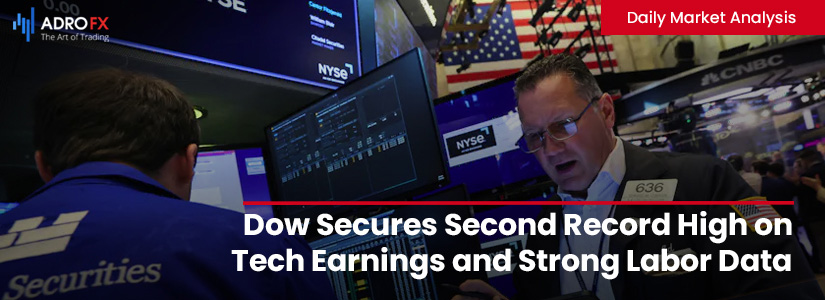
Key events:
- Eurozone - German CPI (MoM) (Jan)
- USA - ADP Nonfarm Employment Change (Jan)
- USA - Chicago PMI (Jan)
- USA - FOMC Statement
- USA - Fed Interest Rate Decision
- USA - FOMC Press Conference
The Dow secured its second consecutive record high on Tuesday, driven by robust quarterly earnings in the big tech sector and encouraging economic data affirming the continued strength of the labor market. The Dow Jones Industrial Average marked a 0.4% increase, gaining 133 points, while the S&P 500 experienced a marginal 0.1% dip, and the Nasdaq Composite faced a 0.8% decline.
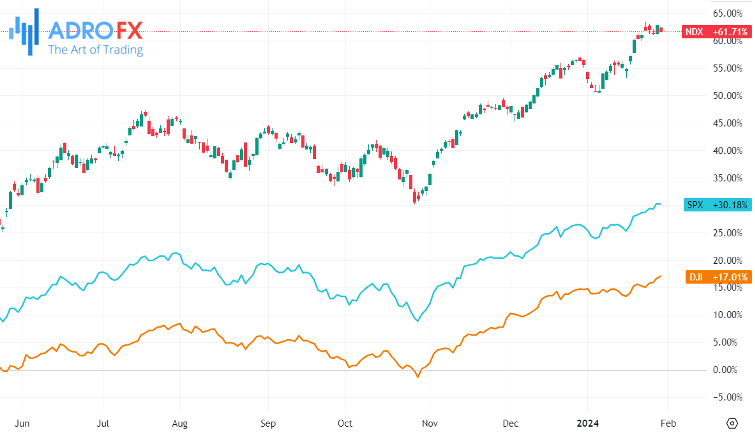
The latest data from the US Labor Department's Job Openings and Labor Turnover Survey indicated a surge in job openings for December, reaching 9.03 million, surpassing economists' estimates of 8.75 million. These positive indicators of labor market resilience coincided with a separate report revealing a two-year high in consumer confidence.
This tandem of reports, highlighting economic robustness, prompted an increase in 2-year Treasury yields as investors anticipated that the Federal Reserve, commencing its two-day meeting, would likely sustain its higher-for-longer rate strategy. Although the Fed was expected to maintain unchanged interest rates, analysts from Stifel suggested that accompanying commentary might emphasize the importance of patience and a balanced risk assessment.
In the tech sector, giants such as Microsoft (NASDAQ: MSFT), Alphabet (NASDAQ: GOOGL), and AMD (NASDAQ: AMD) initiated the earnings season on a positive note, surpassing expectations. Their performances set the stage for upcoming earnings reports from Amazon, Apple, and Meta later in the week. Together, the market capitalization of Alphabet, Microsoft, Apple (NASDAQ: AAPL), Amazon (NASDAQ: AMZN), and Meta (NASDAQ: META) contributed significantly to the S&P 500's 24% gain in 2023.
Shifting focus to the Eurozone, economic activity in the last quarter of 2023 remained stagnant, with Q4 GDP growth at 0.0% quarter-on-quarter. Despite this stagnation, a resilient labor market prevented a collapse in activity. The growth figures afford the European Central Bank additional time before considering the first interest rate cut. Additionally, Spanish inflation in January surpassed expectations, presenting an upside risk to the Eurozone's overall inflation print. Headline HICP stood at 3.5%, exceeding the consensus of 3.0%, while core CPI reached 3.6%, surpassing expectations of 3.3%. The notable uptick in core inflation suggests substantial adjustments in menu prices alongside anticipated high energy inflation.
NZD/USD is consolidating after experiencing intraday losses, putting a pause on its two-day winning streak. The pair is currently trading lower around 0.6120 during the early European session on Wednesday. The US Dollar is gaining strength against the New Zealand Dollar with positive momentum ahead of the Federal Reserve's interest rate decision scheduled later in the day.

Market participants seem to have already incorporated the expectation that the Fed is unlikely to make adjustments in its January meeting. This anticipation impacts the US Dollar's strength as investors align themselves with these expectations.
The US Dollar Index rebounded, reaching nearly 103.60 after a three-day decline, despite a decrease in US Treasury yields. Both the 2-year and 10-year yields on US bond notes saw a decline, standing at 4.31% and 4.00%, respectively, at the current moment. This drop in US yields may potentially apply pressure on the US Dollar.
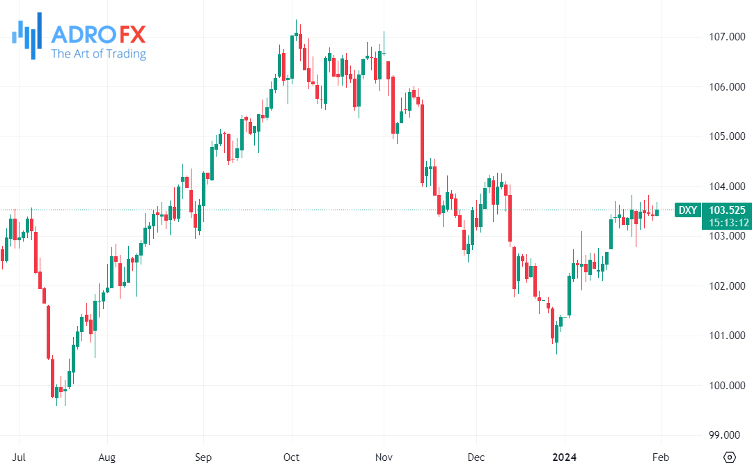
Reserve Bank of New Zealand Chief Economist Paul Conway has adopted a hawkish stance, diverging from expectations for rate cuts. In a statement on Tuesday, Conway conveyed a cautious yet optimistic perspective on the efficacy of the existing monetary policy measures.
Apart from that, the Pound Sterling faces pressure during Wednesday's European morning as the market awaits the US Federal Reserve's monetary policy meeting. The GBP/USD pair is exhibiting mostly sideways movement, with anticipations of decisive action following the announcements from the Fed and the Bank of England for the first monetary policy decisions of 2024. The BoE is expected to maintain the status quo for the fourth consecutive time. Despite the rise in price pressures in the UK economy, there is investor skepticism about inflation returning to the 2% target in a sustained manner.
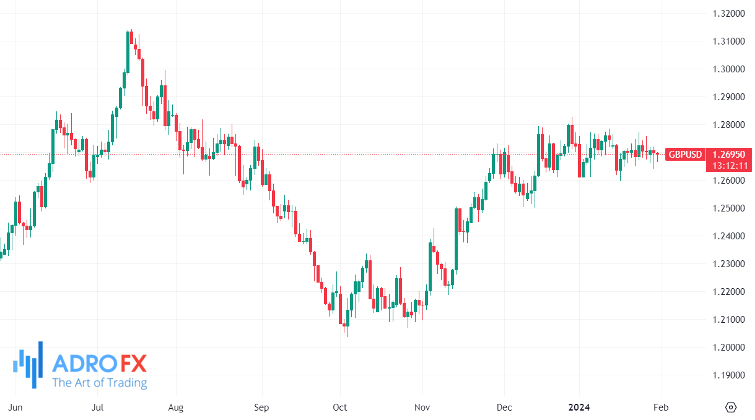
The Australian Dollar is experiencing a downward trend on Wednesday following lower-than-expected Australian inflation in the December quarter. Traders are factoring in the potential for up to two rate cuts from the Reserve Bank of Australia throughout the year. The prevailing risk-off sentiment intensifies the downward pressure on the AUD/USD pair amid increased tensions in the Middle East.
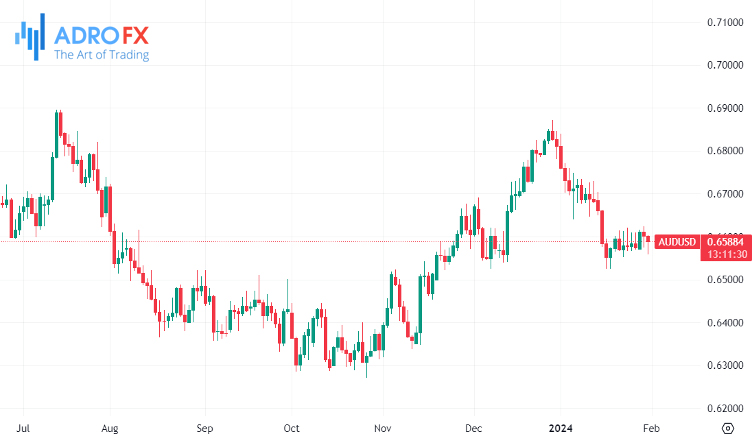
Australia's Monthly Consumer Price Index for December reported a year-on-year increase of 3.4%, down from November's 4.3% and below the expected 3.7%. The RBA Trimmed Mean CPI (YoY) for the fourth quarter was 4.2%, a decline from the previous 5.2%, and lower than the expected 4.3%. The CPI (QoQ) figure came in at 0.6%, softer than the anticipated 0.8% and a notable decrease from the previous reading of 1.2%.
While the current figures fall outside the Reserve Bank of Australia's target range for inflation (2.0% to 3.0%), they signify a noteworthy improvement compared to the peak CPI rate of close to 8.0%. The RBA's policy meeting is scheduled for February 5 and 6, with widespread expectations that interest rates will remain unchanged.









